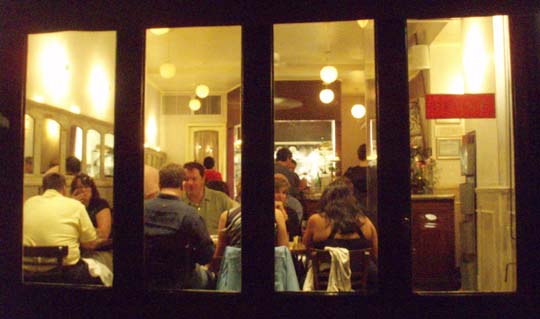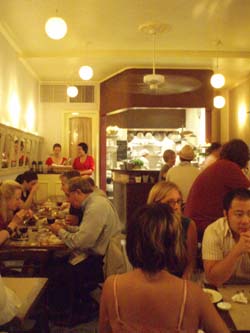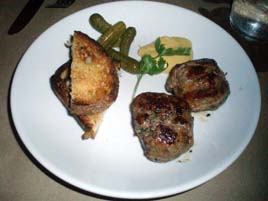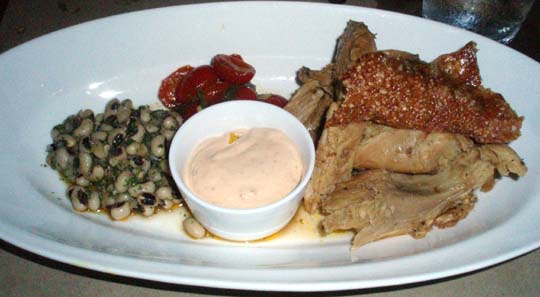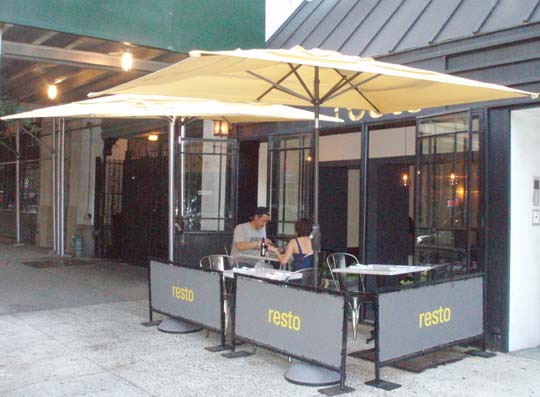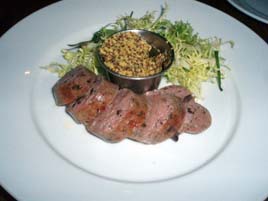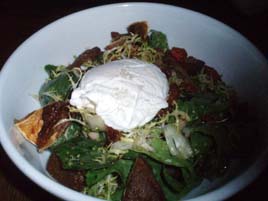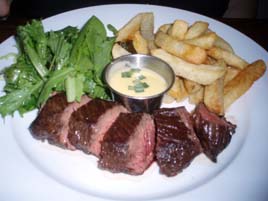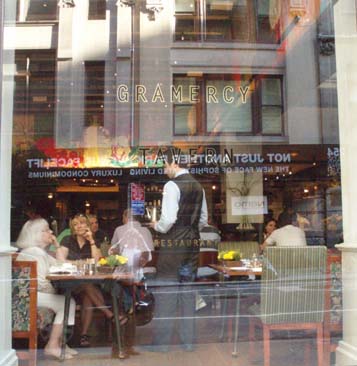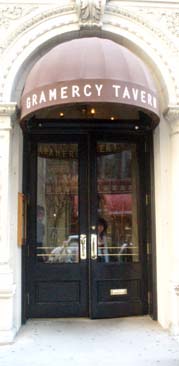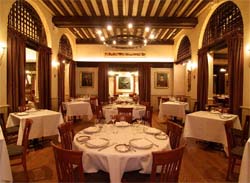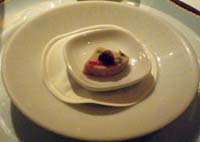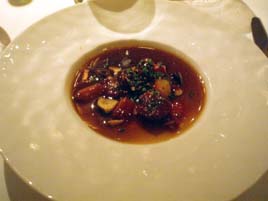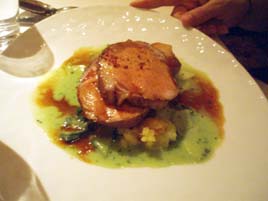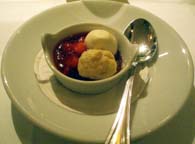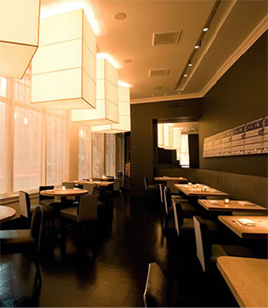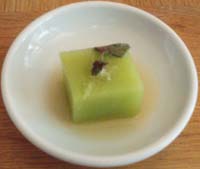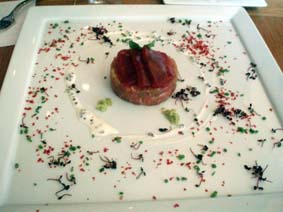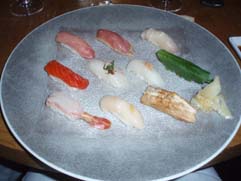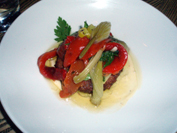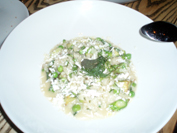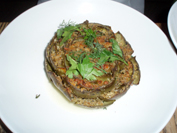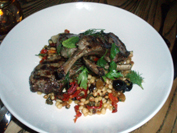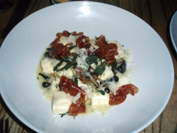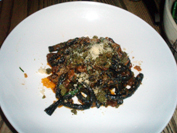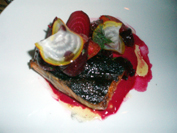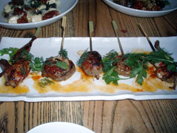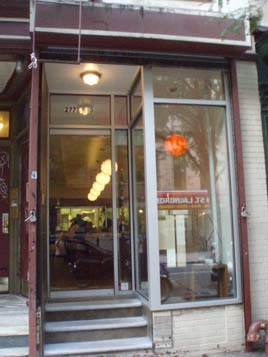
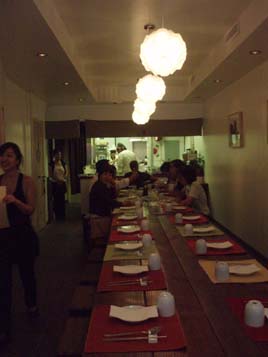
Note: Persimmon closed as of August 2009. The space became The Brindle Room.
*
The new Korean restaurant Persimmon opened quietly in the East Village a couple of months ago. So far, it has rave reviews in New York and the Village Voice to its name.
Critics have noted the similarity to Momofuku Ko: low seating capacity (24), backless stools, and a prix-fixe Korean-inspired menu that goes heavy on the pork and kimchi. The staffing level is similar to Ko: four chefs, a dishwasher, and two servers. The head man, Youngsun Lee, even has some Momofuku time on his resume.
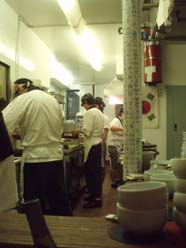
The open kitchen
The differences are significant, too. Dinner is $37 for five courses—a stunningly good value. There is a printed menu, which changes bi-weekly, offering four or five choices for the appetizer, mid-course, and main course. The cuisine is more authentically Korean, in contrast to David Chang’s Momofuku empire, which borrows from many cultures and cooking styles.
Most importantly, you can get into Persimmon without playing Momofuku Ko’s website lottery. Reservations are accepted by phone and seem to be readily available. Persimmon caters to a late-arriving East Village crowd: less than half full at 8:00 p.m. on a Saturday evening, but full by 9:30.
Persimmon isn’t as good as Ko, but at roughly one-third the price it is well worth your time and attention. There will be a new menu by the time you read this, but it will give an idea of what Chef Lee is up to.
The restaurant seats twenty at a long communal table, and four at a bar that faces the open kitchen. We were lucky enough to be seated at the bar, so we were able to watch the food being prepared and have a dialog with the chef.
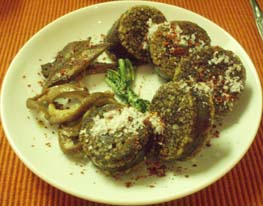
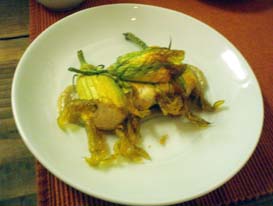
Left: Grilled Korean Blood Sausage; Right: Fried Stuffed Squash Blossoms
I started with the Grilled Korean Blood Sausage, served with pig’s liver, pig’s stomach, scallions and Korean herbs. The menu admits that the sausage comes from Min Sok Restaurant in Flushing. It’s an understatement to say that this dish isn’t for everybody, but I loved the salty, hot, intense flavor.
My girlfriend was impressed with the Fried Stuffed Squash Blossoms, filled with scallop, tofu, and Korean miso. Squash blossom season is ending, so this dish is almost certainly no longer on the menu.
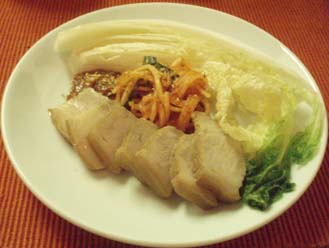
Sliced Braised Pork Belly
For the second course, we both chose the Sliced Braised Pork Belly, or Bo Ssäm. Despite the similar name, don’t expect the Momofuku Ssäm Bar version. The pork comes pre-sliced, with kimchi, salted Napa cabbage and salted baby shrimp on the side.
I thought the pork was a bit too bland. As you can see in the photo, it’s unadorned white squares of pork. My girlfriend didn’t share that complaint, perhaps because her portion had more fat. We both loved the intense moo woo kimchi, which I used as a meat garnish.
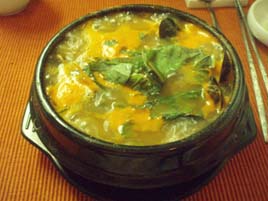

Right: Monkfish Stew; Left: Kimchi Stew
All of the main courses are soups or stews. My girlfriend chose the Kimchi Stew, with onion, tofu, scallions, mushrooms and pork. I had the Monkfish stew with mussels, soybean sprouts, red peppers, chives, garlic and honey.
Both stews came out in their own crockpots, so hot that the broth was still bubbling. Had they spilled on us at that point, we would have been in the E.R. with first-degree burns. It was quite a while before we could dare taste them. Both were spicy and intensely flavorful. Mine was filled with huge chunks of monkfish, vegetables, and a good half-dozen clams. Eating it without a knife (not supplied, and not available) was a challenge, though well worth it. I don’t normally like to work for my food, but this was a rewarding exception.


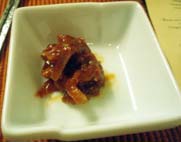
Left: Browned Rice Porridge; Center: Korean cookies; Right: Fermented fish intestines
No choice is offered for the last two courses, and both were letdowns. The chef assured us that Browned Rice Porridge is a Korean standard, but to us it just seemed like dull rice with warm tea poured over it. There was a far better rice side dish served with the main course. A second rice dish didn’t really add much. Dessert came in the form of traditional Korean cookies (sesame, black sesame and wild sesame), which were dry and a bit unexciting.
There were various side dishes served with the meal. I don’t remember them all, but they were mostly terrific, especially a bowl of kimchi-infused vegetables that we regretted we were too full to finish. Then again, maybe it was too much of a good thing. I also liked a serving of dried salted anchovies, but I don’t recommend the fermented fish intestines.
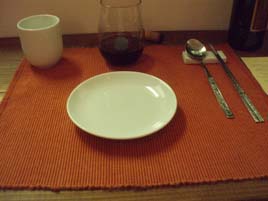 Persimmon is BYOB, and apparently there’s no intention to change that, but they have nice stemless glasses and ice buckets for white wine. Taken with the almost unbelievably low $37 prix fixe, Persimmon must be one of the best deals in town.
Persimmon is BYOB, and apparently there’s no intention to change that, but they have nice stemless glasses and ice buckets for white wine. Taken with the almost unbelievably low $37 prix fixe, Persimmon must be one of the best deals in town.
The service staff were friendly and kept on top of things, but the restaurant didn’t really get crowded until the end of our meal. The décor is spare but pleasant, assuming you don’t mind the backless stools. The orange placemats and decorative metal chopsticks were a nice touch, but silverware was not replaced between courses.
The New York review said that the multi-course meal “requires the dedication of the greater part of an evening.” We didn’t find that to be the case; our meal took about 90 minutes, of which about 20 minutes was the time it took for our main courses to cool down to a safe temperature.
Some of the food here is adventurous (blood sausage, fish intestines), but there are “safe” choices for every course, such as chicken dumplings, grilled scallops and miso stew with seafood. There is at least one vegetarian option for each course.
Persimmon is a first-class experience of its kind, and a welcome addition to a Momofuku-dominated neighborhood.
Persimmon (277 E. 10th Street, west of Avenue A, East Village)
Food: **
Service: *½
Ambiance: *½
Overall: **
 Wednesday, September 10, 2008 at 02:28PM
Wednesday, September 10, 2008 at 02:28PM 

